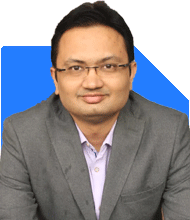I am 24 years old and my current savings is rs 5000/- What suitable ideas do you have for long term that can give you good returns and can also potentially help you for future
Ans: As a Certified Financial Planner, I commend you on your foresight in seeking to secure your financial future. At 24, you have the advantage of time on your side. This allows you to leverage the power of compounding to grow your wealth. With an initial savings of Rs 5000/-, you can explore several long-term investment strategies that offer good returns and align with your future goals. Let’s dive into the various options available to you, keeping your specific circumstances and the Indian financial market in mind.
Understanding Your Financial Goals
Before diving into specific investment strategies, it's crucial to understand your financial goals. Are you saving for a house, a car, or your retirement? Defining your goals will help tailor your investment strategy accordingly.
Emergency Fund
First and foremost, it’s essential to have an emergency fund. This fund should cover 3 to 6 months of your living expenses. It acts as a safety net during unexpected situations like job loss or medical emergencies. You can park your emergency fund in a high-interest savings account or a liquid fund for easy accessibility and decent returns.
Systematic Investment Plan (SIP) in Mutual Funds
A Systematic Investment Plan (SIP) in mutual funds is a disciplined approach to investing. It allows you to invest a fixed amount regularly, irrespective of the market conditions. SIPs benefit from rupee cost averaging and compounding returns. Over time, these small investments grow significantly, providing substantial returns. Mutual funds offer diversification, reducing risk by spreading investments across various sectors and assets.
Actively Managed Funds
Actively managed funds are preferable over index funds for several reasons. These funds are managed by professional fund managers who actively make investment decisions to outperform the market. They have the flexibility to adjust the portfolio based on market conditions, which can lead to higher returns. Index funds, on the other hand, simply replicate the performance of a market index, offering limited scope for outperformance.
Equity Mutual Funds
Equity mutual funds invest in stocks and have the potential to deliver higher returns over the long term. They are suitable for young investors with a high risk tolerance and a long investment horizon. Equity funds come in various types, such as large-cap, mid-cap, and small-cap funds. Diversifying your investments across these categories can provide a balanced risk-return profile.
Debt Mutual Funds
Debt mutual funds invest in fixed-income securities like government bonds, corporate bonds, and money market instruments. They offer more stability and lower risk compared to equity funds. Including debt funds in your portfolio can provide a stable income and act as a cushion against market volatility.
Diversified Portfolio
Creating a diversified portfolio is crucial for long-term wealth creation. Diversification involves spreading investments across various asset classes like equities, debt, and gold. This strategy helps in minimizing risk and maximizing returns. Regularly review and rebalance your portfolio to ensure it aligns with your financial goals and market conditions.
Retirement Planning
Starting retirement planning early gives you a significant advantage. Investing in the National Pension System (NPS) can be a prudent choice. NPS offers tax benefits, flexibility in investment options, and a steady income post-retirement. Additionally, consider investing in Public Provident Fund (PPF) for its safety, tax benefits, and decent returns.
Systematic Transfer Plan (STP)
A Systematic Transfer Plan (STP) allows you to transfer a fixed amount from one mutual fund to another. It’s an excellent strategy for gradually moving investments from a debt fund to an equity fund or vice versa. STPs help in mitigating risk by averaging the purchase cost and providing better returns.
Avoiding Investment Mistakes
It’s crucial to avoid common investment mistakes like chasing high returns, timing the market, and not diversifying enough. Stay focused on your long-term goals and maintain a disciplined investment approach. Regularly review your investments and make adjustments as needed.
Insurance Planning
Insurance is a critical component of financial planning. It’s essential to have adequate health and life insurance coverage to protect yourself and your family from unforeseen events. Avoid mixing insurance with investment. Policies like Unit Linked Insurance Plans (ULIPs) and investment-cum-insurance products often offer suboptimal returns and high charges. It’s better to surrender these policies and reinvest the amount in mutual funds for better growth.
Tax Planning
Effective tax planning can enhance your investment returns. Utilize tax-saving investment options like Equity Linked Savings Schemes (ELSS), PPF, and NPS. These instruments not only help in reducing your taxable income but also provide good returns over the long term.
Financial Discipline
Maintaining financial discipline is key to successful investing. Automate your investments through SIPs, avoid unnecessary expenses, and regularly save a portion of your income. Keeping track of your expenses and sticking to a budget can help you save more and invest consistently.
Continuous Learning
The financial market is dynamic, and staying informed is crucial. Continuously educate yourself about new investment options, market trends, and financial planning strategies. Reading financial blogs, attending webinars, and consulting with a Certified Financial Planner can provide valuable insights.
Starting Small
Starting with Rs 5000/- is a great step. As your income grows, gradually increase your investment amount. The key is to start early and invest consistently. Even small amounts can grow significantly over time through the power of compounding.
Review and Rebalance
Regularly reviewing and rebalancing your portfolio is essential. Market conditions and your financial goals may change over time. Adjust your portfolio to ensure it remains aligned with your objectives and risk tolerance.
Benefits of Professional Guidance
Working with a Certified Financial Planner can provide you with personalized advice and help you navigate the complexities of investing. They can assist in creating a comprehensive financial plan, selecting suitable investment options, and achieving your financial goals.
Assessing Your Risk Tolerance
Understanding your risk tolerance is crucial in selecting appropriate investment options. Younger investors often have a higher risk tolerance due to their long investment horizon. However, it’s essential to balance high-risk investments with safer options to maintain stability.
Investing in Yourself
Investing in your skills and education can yield significant returns. Enhance your career prospects through continuous learning, certifications, and professional development. Higher earning potential translates to more savings and investments in the future.
Goal-Based Investing
Aligning your investments with specific goals can provide clarity and motivation. Create separate portfolios for different goals like buying a house, children's education, or retirement. This approach helps in tracking progress and staying committed to your financial objectives.
Benefit of Starting Early
Starting your investment journey early provides the advantage of time. Compounding works best over a long period, turning small investments into substantial wealth. The earlier you start, the more you benefit from compounding.
Flexibility and Liquidity
Choose investment options that offer flexibility and liquidity. While long-term investments are crucial, having access to funds during emergencies is equally important. Balance your portfolio with a mix of liquid and long-term assets.
Understanding Market Cycles
The market goes through cycles of ups and downs. Understanding these cycles can help you stay calm during market volatility. Avoid panic selling during market downturns and stay invested for the long term to reap the benefits of recovery.
Staying Updated with Regulatory Changes
Stay informed about regulatory changes that impact your investments. Changes in tax laws, interest rates, and investment regulations can affect your returns. Regularly consult with your Certified Financial Planner to stay updated and make necessary adjustments.
Avoiding High-Cost Investments
High-cost investment products can erode your returns. Be mindful of the fees and charges associated with investment options. Opt for low-cost mutual funds and avoid high-cost ULIPs and other investment-cum-insurance products.
Power of Compounding
The power of compounding is a fundamental principle of investing. It involves earning returns on your initial investment and the accumulated returns. The longer you stay invested, the more your money grows exponentially.
Inflation and Investment
Consider inflation while planning your investments. Inflation reduces the purchasing power of your money over time. Choose investment options that offer returns higher than the inflation rate to maintain your wealth’s real value.
Future Financial Security
Investing wisely today ensures financial security for the future. It provides the means to achieve your goals, enjoy a comfortable lifestyle, and handle emergencies with ease. Start early, stay disciplined, and make informed investment decisions.
Monitoring Your Investments
Regularly monitoring your investments is crucial. Keep track of the performance, review your portfolio, and make necessary adjustments. Staying informed and proactive ensures your investments stay on track to meet your goals.
Long-Term Perspective
Investing with a long-term perspective is essential. Short-term market fluctuations are common, but long-term investments typically yield better returns. Stay patient and avoid making impulsive decisions based on short-term market movements.
Diversification Across Sectors
Diversification is not just about asset classes but also sectors. Spread your investments across different industries to mitigate sector-specific risks. A well-diversified portfolio enhances stability and growth potential.
Understanding Mutual Fund Categories
Mutual funds come in various categories, each with different risk-return profiles. Understand the categories and choose funds that align with your financial goals and risk tolerance. This ensures a balanced and effective investment strategy.
Reinvesting Returns
Reinvesting the returns from your investments accelerates the growth of your wealth. Instead of withdrawing the returns, reinvest them to benefit from compounding. This strategy significantly boosts your long-term returns.
Setting Realistic Expectations
Set realistic expectations for your investment returns. High returns come with higher risks. It’s crucial to balance your return expectations with the associated risks to avoid disappointments and stay committed to your investment plan.
Financial Independence
Achieving financial independence is a significant milestone. It provides the freedom to pursue your passions, retire early, and enjoy a comfortable lifestyle. Consistent investing and disciplined financial planning are key to reaching this goal.
Conclusion
Investing wisely and consistently is the cornerstone of building a secure financial future. With an initial savings of Rs 5000/-, you have made a commendable start. By adopting a disciplined approach, diversifying your investments, and staying informed, you can achieve substantial growth and financial security. Remember, the journey to wealth creation is a marathon, not a sprint. Stay patient, stay focused, and your efforts will pay off in the long run.
Best Regards,
K. Ramalingam, MBA, CFP,
Chief Financial Planner,
www.holisticinvestment.in













.jpg)













